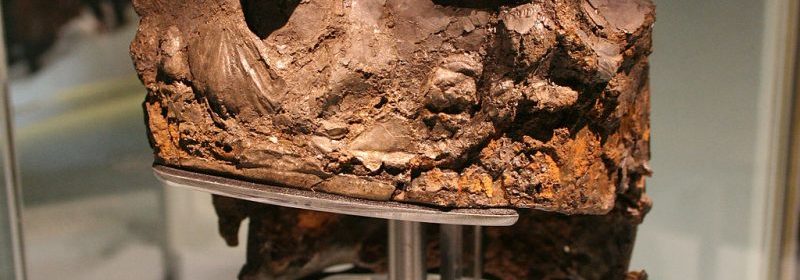Unique Roman cavalry helmet pieced together 10 years after discovery

Unique Roman cavalry helmet pieced together 10 years after discovery
The Hallaton Helmet is an iron Roman cavalry parade helmet, which was originally coated in silver and adorned with gold leaf. The helmet was discovered by a retired teacher and amateur archaeologist, Ken Wallace, who was 71 years old.

He and other Hallaton Fieldwork Group members found roman pottery pieces on a hill near Hallaton in 2000.
One evening he visited the site with a metal detector and found about 200 coins that were buried in a series of small pits dug into the clay.
He also found another artefact that he left overnight in the ground. The next day he went back to look at his find and found it to be a silver ear.
The discovery was announced to the archaeologist of Leicestershire’s county, who called University Leicester Archaeological Services (ULAS) to excavate the site.
The helmet is an example of a three-piece Roman ceremonial cavalry helmet, made of sheet iron covered with silver sheet and partly decorated with gold leaf.
Such helmets were worn by Roman auxiliary cavalrymen in displays known as hippika gymnasia and may also have been worn in battle, despite their relative thinness and lavish decoration.
Horses and riders wore lavishly decorated clothes, armour and plumes while performing feats of horsemanship and re-enacting historical and legendary battles, such as the wars of the Greeks and Trojans.
It is the only Roman helmet ever found in Britain that still has most of its silver-gilt plating attached.The helmet would originally have had two cheekpieces attached via holes in front of its ear guards.
It has a prominent brow guard, the shape of which is similar to that of the 3rd-century Guisborough Helmet, discovered in 1864 near Guisborough in Redcar and Cleveland. The rear of the helmet bowl descended to form a neck guard
The helmet was too fragile to be excavated in situ so it was removed within a block of earth held together with plaster of Paris.

It was taken to the British Museum in London for conservation, which took nine years of work by conservator Marilyn Hockey and her colleagues Fleur Shearman and Duygu Çamurcuoğlu.
Corrosion and the effects of time had shattered the helmet into thousands of pieces,most of which were smaller than the nail on a person’s little finger.The reconstructed and conserved helmet was unveiled in January 2012.
Leicester County Council was able to raise £1 million to buy the entire hoard and pay for the conservation of the helmet, with the assistance of donations from the Heritage Lottery Fund (which gave a £650,000 grant), the Art Fund and other trusts and charities.
The helmet was valued at £300,000; under the terms of the Treasure Act, Ken Wallace and the landowner were each awarded £150,000.
The helmet was put on permanent public display at the end of January 2012 at the Harborough Museum in Market Harborough, nine miles from the site where the hoard was found, alongside other objects found at Hallaton.